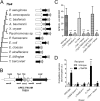Two functional type VI secretion systems in avian pathogenic Escherichia coli are involved in different pathogenic pathways
- PMID: 24980972
- PMCID: PMC4187841
- DOI: 10.1128/IAI.01769-14
Two functional type VI secretion systems in avian pathogenic Escherichia coli are involved in different pathogenic pathways
Erratum in
-
Correction for Ma et al., two functional type VI secretion systems in avian pathogenic Escherichia coli are involved in different pathogenic pathways.Infect Immun. 2015 Aug;83(8):3340. doi: 10.1128/IAI.00615-15. Infect Immun. 2015. PMID: 26157089 Free PMC article. No abstract available.
Abstract
Type VI secretion systems (T6SSs) are involved in the pathogenicity of several Gram-negative bacteria. The VgrG protein, a core component and effector of T6SS, has been demonstrated to perform diverse functions. The N-terminal domain of VgrG protein is a homologue of tail fiber protein gp27 of phage T4, which performs a receptor binding function and determines the host specificity. Based on sequence analysis, we found that two putative T6SS loci exist in the genome of the avian pathogenic Escherichia coli (APEC) strain TW-XM. To assess the contribution of these two T6SSs to TW-XM pathogenesis, the crucial clpV clusters of these two T6SS loci and their vgrG genes were deleted to generate a series of mutants. Consequently, T6SS1-associated mutants presented diminished adherence to and invasion of several host cell lines cultured in vitro, decreased pathogenicity in duck and mouse infection models in vivo, and decreased biofilm formation and bacterial competitive advantage. In contrast, T6SS2-associated mutants presented a significant decrease only in the adherence to and invasion of mouse brain microvascular endothelial cell (BMEC) line bEnd.3 and brain tissue of the duck infection model. These results suggested that T6SS1 was involved in the proliferation of APEC in systemic infection, whereas VgrG-T6SS2 was responsible only for cerebral infection. Further study demonstrated that VgrG-T6SS2 was able to bind to the surface of bEnd.3 cells, whereas it did not bind to DF-1 (chicken embryo fibroblast) cells, which further proved the interaction of VgrG-T6SS2 with the surface of BMECs.
Copyright © 2014, American Society for Microbiology. All Rights Reserved.
Figures









Similar articles
-
Genetic diversity and features analysis of type VI secretion systems loci in avian pathogenic Escherichia coli by wide genomic scanning.Infect Genet Evol. 2013 Dec;20:454-64. doi: 10.1016/j.meegid.2013.09.031. Epub 2013 Oct 8. Infect Genet Evol. 2013. PMID: 24120694
-
Functional role of ompF and ompC porins in pathogenesis of avian pathogenic Escherichia coli.Microb Pathog. 2017 Jun;107:29-37. doi: 10.1016/j.micpath.2017.02.033. Epub 2017 Mar 14. Microb Pathog. 2017. PMID: 28315387
-
Characterization of multiple type-VI secretion system (T6SS) VgrG proteins in the pathogenicity and antibacterial activity of porcine extra-intestinal pathogenic Escherichia coli.Virulence. 2019 Dec;10(1):118-132. doi: 10.1080/21505594.2019.1573491. Virulence. 2019. PMID: 30676217 Free PMC article.
-
The different roles of hcp1 and hcp2 of the type VI secretion system in Escherichia coli strain CE129.J Basic Microbiol. 2018 Nov;58(11):938-946. doi: 10.1002/jobm.201800156. Epub 2018 Sep 3. J Basic Microbiol. 2018. PMID: 30247772
-
DotU expression is highly induced during in vivo infection and responsible for virulence and Hcp1 secretion in avian pathogenic Escherichia coli.Front Microbiol. 2014 Nov 7;5:588. doi: 10.3389/fmicb.2014.00588. eCollection 2014. Front Microbiol. 2014. PMID: 25426107 Free PMC article.
Cited by
-
ArcA Controls Metabolism, Chemotaxis, and Motility Contributing to the Pathogenicity of Avian Pathogenic Escherichia coli.Infect Immun. 2015 Sep;83(9):3545-54. doi: 10.1128/IAI.00312-15. Epub 2015 Jun 22. Infect Immun. 2015. PMID: 26099584 Free PMC article.
-
Roles of Hcp family proteins in the pathogenesis of the porcine extraintestinal pathogenic Escherichia coli type VI secretion system.Sci Rep. 2016 May 27;6:26816. doi: 10.1038/srep26816. Sci Rep. 2016. PMID: 27229766 Free PMC article.
-
Whole-genome sequencing analysis of Shiga toxin-producing Escherichia coli O22:H8 isolated from cattle prediction pathogenesis and colonization factors and position in STEC universe phylogeny.J Microbiol. 2022 Jul;60(7):689-704. doi: 10.1007/s12275-022-1616-z. Epub 2022 Jun 22. J Microbiol. 2022. PMID: 35731345
-
Phosphopantetheinyl transferase ClbA contributes to the virulence of avian pathogenic Escherichia coli in meningitis infection of mice.PLoS One. 2022 Jul 28;17(7):e0269102. doi: 10.1371/journal.pone.0269102. eCollection 2022. PLoS One. 2022. PMID: 35900973 Free PMC article.
-
RyhB in Avian Pathogenic Escherichia coli Regulates the Expression of Virulence-Related Genes and Contributes to Meningitis Development in a Mouse Model.Int J Mol Sci. 2022 Dec 8;23(24):15532. doi: 10.3390/ijms232415532. Int J Mol Sci. 2022. PMID: 36555174 Free PMC article.
References
-
- Dho-Moulin M, Fairbrother JM. 1999. Avian pathogenic Escherichia coli (APEC). Vet. Res. 30:299–316 - PubMed
-
- Zhao L, Gao S, Huan H, Xu X, Zhu X, Yang W, Gao Q, Liu X. 2009. Comparison of virulence factors and expression of specific genes between uropathogenic Escherichia coli and avian pathogenic E. coli in a murine urinary tract infection model and a chicken challenge model. Microbiology 155:1634–1644. 10.1099/mic.0.024869-0 - DOI - PubMed
-
- Gunther NT, Snyder JA, Lockatell V, Blomfield I, Johnson DE, Mobley HL. 2002. Assessment of virulence of uropathogenic Escherichia coli type 1 fimbrial mutants in which the invertible element is phase-locked on or off. Infect. Immun. 70:3344–3354. 10.1128/IAI.70.7.3344-3354.2002 - DOI - PMC - PubMed
Publication types
MeSH terms
Substances
LinkOut - more resources
Full Text Sources
Other Literature Sources
Medical
Miscellaneous

